Module 2 Intro
| Site: | MoodleHUB.ca 🍁 |
| Course: | Biology 20 SS |
| Book: | Module 2 Intro |
| Printed by: | Guest user |
| Date: | Wednesday, 24 December 2025, 11:05 AM |
Description
Created by IMSreader
1. Module 2 Intro
Module 2—Biosphere Equilibrium and the Impact of Humans
Module Introduction
In this module you will explore the balancing act of the biosphere and how human activities can disrupt the cycling of matter and energy flow. You will also look at the impact of these activities on the global climate.
You will be looking at the following essential questions in this module:
-
How are energy, matter, and ecosystem productivity interrelated?
-
How does the relationship between gas exchange in photosynthesis and cellular respiration influence the composition of the atmosphere?
-
How do human activities influence the biosphere?
At the end of this module, you will complete a Module Project based on your reflections and research involving the human impact on Canada’s Arctic. When have completed Module 2, go to Module Summary and Assessment for detailed instructions about the project.
Once you have finished your Module Project, you will be ready to complete the final Unit Assessment. This is located in the Unit Conclusion.
1.1. Big Picture
Module 2—Biosphere Equilibrium and the Impact of Humans
 Big Picture
Big Picture
“Use what is happening in the Arctic—the Inuit Story—as a vehicle to reconnect us all, so that we may understand that the planet and its people are connected as one.”
—Sheila Watt-Cloutier, Canadian Inuit leader asking members of the US senate to consider how the Arctic is connected to the rest of the world in response to their refusal to sign the Kyoto Protocol (plan to reduce greenhouse gas emissions)
When you watch television, listen to the radio, surf the Internet, or read magazines, you are often bombarded with information about climate change or global warming. All of the information in the media implies there is a direct link between greenhouse gases and climate change. Greenhouse gas emissions actually change the balance of energy and matter in the biosphere, which scientists propose is the cause of global warming.
Albertans contribute to greenhouse gas emissions: therefore, people in Alberta are connected to the balance of energy in the biosphere. Unfortunately, some of the effects of climate change are observed in our own “backyard”—the Canadian Arctic.

© John Pitcher/iStockphoto
Are you aware that the Canadian Arctic, the biosphere’s air-conditioning unit, is seriously affected by global warming? Do you know that the ice shelves are melting at an alarming rate and that summers in the Arctic are lasting longer than ever before? Do you know that climate change may be negatively affecting polar bears?
You might be asking yourself, “Why should I care about longer summers, ice shelves, and polar bears?” Another question could be, “What’s the big deal about a few degrees of difference in Arctic temperatures?” Scientists believe that the fragile Arctic ecosystem serves as an early-warning system for the entire biosphere!
If one part of this ecosystem is affected, then all of the other systems must also be affected. Do you believe that “the planet and its people are connected as one”? Can you describe how you are connected? If people are all connected as one, then it must be assumed that all the actions taken will affect others—for good or for bad.
So this is the question for Module 2: What effects do humans have on biosphere equilibrium?
To know what effects humans have on biosphere equilibrium, you will need to work through these essential questions:
-
How are energy, matter, and ecosystem productivity interrelated?
-
How does the relationship between gas exchange in photosynthesis and cellular respiration influence the composition of the atmosphere?
-
How do human activities influence the biosphere?
In addition to the lesson assignments and labs, there will be a Module Project to complete. You will be required to prepare a PowerPoint or a multimedia presentation, essay, speech, or storyboard exploring a specific example of how global warming is affecting the Arctic ecosystem in terms of energy and matter.
When you are ready for more information about the project, go to the Module Summary and Assessment for instructions and a rubric identifying how your work will be marked.
1.2. In this Module
Module 2—Biosphere Equilibrium and the Impact of Humans
In This Module
Lesson 1—Ecosystem Productivity: A Balance Between Energy and Matter
This lesson looks at how the balance of energy and matter can be observed in the biosphere. Biotic and abiotic processes help to maintain the balance of matter and energy exchange in the biosphere. Productivity is influenced by environmental factors such as sunlight and nutrient availability. As you move on from this module, you will continue to look at how human influence can affect biosphere equilibrium.
- How are energy, matter, and ecosystem productivity interrelated?
Lesson 2—Gas Exchange Equilibrium
This lesson will describe the gas exchange equilibrium that exists in the biosphere. As always, the balance can be affected by human activity. Your job is to make sure you can answer the following question and apply what you know when you factor in the consequences of technology:
-
How does the relationship between gas exchange in photosynthesis and cellular respiration influence the composition of the atmosphere?
Lesson 3—The Ecological Footprint of Humans
This lesson will focus on mankind’s ecological footprint. You will learn about how humans can interfere either intentionally or unintentionally with the cycling of matter. Studying changes to Earth’s atmosphere over recent history will provide an example of how human activity presently affects atmospheric composition. You will then look at the relationship between biogeochemical cycles, atmospheric composition, and the climate. You will explore the following question:
- How do human activities influence the biosphere?
 Module Assessment
Module Assessment
You will be graded according to the work you complete for the lesson assignments and the module project. The module project is the final assignment for Module 2.
1.3. Lesson 1 Intro
Module 2—Biosphere Equilibrium and the Impact of Humans
Lesson 1—Ecosystem Productivity: A Balance Between Energy and Matter
 Get Focused
Get Focused
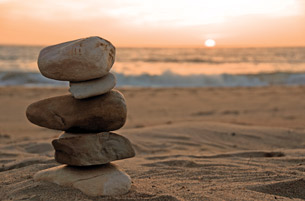
© Denise Bentley/iStockphoto
What is the balancing act that keeps everything together? Are systems unchanging and static? No. In fact, the systems are dynamic. You may have heard the word dynamic used to describe a character who adapts to the environment. Equilibrium on Earth is dynamic—matter and energy fluctuate but are kept in balance by systems within the biosphere. As you look outdoors once again, you will see that the balance between finite and infinite resources can be measured and observed. The question for you to answer is “how?”
As you work through this module, you will be required to answer Reflect on the Big Picture and Reflect and Connect questions from each of the three lessons. These responses will be stored in your course folder. You will be using your responses as a planning tool to respond to the final module written assignment. You do not need to submit the responses to your teacher for assessment, but you may request feedback if it will assist your work towards the module project.
Consider the following question as you complete this lesson:
-
How are energy, matter, and ecosystem productivity interrelated?
 Module 2: Lesson 1 Assignment
Module 2: Lesson 1 Assignment
Your teacher-marked Module 2: Lesson 1 Assignment requires you to submit a response to the following:
-
Lab 1: Thought Lab 2.3: Too Much of a Good Thing
You can access your Module 1: Lesson 1 Assignment. You can print off the assignment or save the download to your computer. Your answers can be saved on this document to your course folder.
The other questions in this lesson are not marked by the teacher; however, you should still answer these questions. The Self-Check and Try This questions are placed in this lesson to help you review important information and build key concepts that may be applied in future lessons.
After a discussion with your teacher, you must decide what to do with the questions that are not part of your assignment. For example, you may decide to submit to your teacher the responses to Try This questions that are not marked. You should record the answers to all the questions in this lesson and place those answers in your course folder.
1.4. Page 2
Module 2—Biosphere Equilibrium and the Impact of Humans
 Explore
Explore
 Read
Read
Begin Lesson 1 by reading pages 53 and 54 of your textbook. You will be instructed to complete the Thought Lab later on in this lesson.
Ecosystem productivity depends on many things and can be measured. Sometimes productivity can be directly or indirectly affected by human actions.
 Self-Check
Self-Check
SC 1. What is productivity?
SC 2. What is significant about algal beds and reefs? (Hint: Refer to “Figure 2.20” on page 53 of your textbook.)
SC 3. Why would the productivity of a tropical seasonal rainforest be greater than tundra? (Hint: Refer to “Figure 2.20” in your textbook.)
 Self-Check Answers
Self-Check Answers
SC 1. Productivity is the rate at which an ecosystem’s producers capture and store energy within organic compounds over a certain length of time. Productivity is measured as energy per area per year (J/m2/a) or in biomass (g/m2/a).
SC 2. Algal beds and reefs take up 0.1% of Earth’s surface area but have the highest productivity in terms of energy.
SC 3. The number of producers present in a tropical seasonal forest would be greater, as would the amount of rainfall. There would also be more heat and light available for more of the year than in the arctic.
A Closer Look at Ecosystem Productivity
Following this more in-depth look at productivity, there are Self-Check questions for you to answer.
The following are characteristics of gross productivity:
- Gross productivity is the amount of energy trapped in plant material during a specified interval at a given trophic level.
- Remember, plants trap only 2% of the solar energy around them.
- At least half of this solar energy is lost by cellular respiration as plants must also access energy for their life processes.
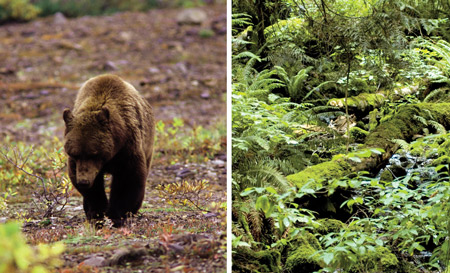
© Lars Johansson/iStockphoto (bear)
© David Mendel/iStockphoto (trees)
The following are characteristics of net productivity:
- Net productivity is the amount of energy trapped in plant material during a specified interval (time) at a given trophic level minus what is lost by cellular respiration of the organisms at that level (measuring biomass).
- One way to determine net productivity is to collect and weigh the plant material produced on 1 m2 of land over a given interval.
- One gram of plant material (e.g., stems and leaves), mostly carbohydrates, yields about 20 J of energy when burned or respired.
The following table shows representative values for the net productivity of a variety of ecosystems—both natural and managed. These values are only approximations and are subject to marked fluctuations because of variations in temperature, fertility, and availability of water.
Estimated Net Productivity of a Variety of Ecosystems (kJ/m2/y) |
|
temperate deciduous forest |
21 000 |
tropical rainforest |
63 000 |
tall-grass prairie |
8400 |
desert |
2100 |
coastal marsh |
50 200 |
ocean close to shore |
10 500 |
open ocean |
3300 |
clear lake |
3300 |
lake in advanced state of eutrophication |
10 500 |
 Self-Check
Self-Check
SC 4. What happens to the net productivity of an ecosystem?
SC 5. How do people directly and indirectly depend on net productivity?
SC 6. In what other ways do people depend on net productivity to meet their needs?
SC 7. How do humans reduce the net productivity of an area?
 Self-Check Answers
Self-Check Answers
SC 4. The net productivity of an ecosystem is harvested by herbivores (deer, insects). Productivity is then transferred down food chains—some is decomposed, and some is stored (growing forests, peat bogs).
SC 5. People directly depend on net productivity by eating plants. Indirectly, people eat other organisms that consume plants or other animal products.
SC 6. For example, people use plant materials for construction, fuel, and for clothing.
SC 7. Humans reduce the net productivity of an area by clearcutting to build roads and houses and to develop agriculture and industry.
1.5. Page 3
Module 2—Biosphere Equilibrium and the Impact of Humans
 Lab
Lab
Lab: Too Much of a Good Thing
Increasing ultraviolet radiation (UVR) can have an impact on ecosystems. In "Thought Lab 2.3: Too Much of a Good Thing," you will be analyzing information from readings and a chart in order to form conclusions about the impact of UVR.
Go to Module 2: Lesson 1 Assignment for directions.

© Li Kim Goh/iStockphoto
 Going Beyond
Going Beyond
Do a web search using the keywords “biomass energy.” It is an interesting topic and may be a more widely used alternative energy source in your future.
 Reflect and Connect
Reflect and Connect
Answer these questions by working your answers into a concise paragraph. How are energy, matter, and ecosystem productivity interrelated? Where do you (humans) fit into this picture? Save your responses to your course folder. Answering these questions will give you some ideas that will be discussed in the unit assessment and module project.
 Reflect on the Big Picture
Reflect on the Big Picture
How would ecosystem productivity be affected in the Arctic as a result of climate change?
This is the first of three Big Picture questions that you will answer. The ideas synthesized here will be stored in your course folder for later use in your module project. Your module project will require you to prepare a PowerPoint or multimedia presentation, essay, speech, or storyboard exploring a specific example of how global warming is affecting the Arctic ecosystem in terms of energy and matter. These questions will help you to explore how human influences (science and technology) can have unintended consequences.
You may want to do some research.
![]() Remember to submit the Assignment answers to your teacher as part of your Module 2: Lesson 1 Assignment.
Remember to submit the Assignment answers to your teacher as part of your Module 2: Lesson 1 Assignment.
1.6. Page 4
Module 2—Biosphere Equilibrium and the Impact of Humans
 Lesson Summary
Lesson Summary
In this lesson you explored the following essential question:
- How are energy, matter, and ecosystem productivity interrelated?
You looked at how the balance of energy and matter can be observed in the biosphere. Biotic and abiotic processes help to maintain the balance of matter and energy exchange in the biosphere. Productivity is influenced by environmental factors such as the availability of sunlight and nutrients. You looked at how UV radiation can have an effect on the productivity of an ecosystem. As you continue working in this module, you will continue to look at how the influence of people can affect biosphere equilibrium.
1.7. Lesson 2 Intro
Module 2—Biosphere Equilibrium and the Impact of Humans
Lesson 2—Gas Exchange Equilibrium
 Get Focused
Get Focused
What could possibly be happening to the air around you? In this video of the moose drinking water, you should be able to identify two activities that are happening which contribute to the equilibrium of oxygen and carbon dioxide (photosynthesis and cellular respiration). Unfortunately, studies of the Arctic seem to indicate that there is an imbalance in the exchange of oxygen and carbon dioxide. It is feared that climate change is a result of an imbalance in gas exchange and, if not counteracted, the biosphere could be in big trouble. How do scientists know that there are changes in Earth’s atmosphere? What do they know about past atmospheric conditions on Earth?
© Courtesy of iStockphoto.com
Scientists have conducted many studies focused on how the biosphere regulates itself. In 1985, construction began on Biosphere 2, a structure built with a closed artifical ecological system designed to study the complex web of interactions of life systems. Using Biosphere 2, scientists could alter the biosphere balance without affecting the real biosphere.
While the Biosphere 2 project was considered by many people in the scientific community to be unsuccessful, it did provide some valuable information. And it did show that the biosphere and its dynamic balance is something that humans cannot easily recreate. One key idea that scientists in Biosphere 2 studied was atmosphere composition, since humans need oxygen to keep alive and plants (autotrophs) need CO2 to survive. In 2007, the University of Arizona took over research at Biosphere 2.
In this lesson you will be exploring the following essential question:
-
How does the relationship between gas exchange in photosynthesis and cellular respiration influence the composition of the atmosphere?
 Module 2: Lesson 2 Assignment
Module 2: Lesson 2 Assignment
Your teacher-marked Module 2: Lesson 2 Assignment requires you to submit a response to the following:
-
TR 1. The Changing Atmosphere and Global Warming
-
Lesson 2 Lab: Biosphere in a Bottle
You can access your Module 2: Lesson 2 Assignment. You can print off the assignment or save the download to your computer. Your answers can be saved on this document to your course folder.
You must decide what to do with the questions that are not marked by the teacher.
Remember that these questions provide you with the practice and feedback that you need to successfully complete this course. You should respond to all the questions and place those answers in your course folder.
1.8. Page 2
Module 2—Biosphere Equilibrium and the Impact of Humans
 Explore
Explore
 Read
Read
Read pages 55 and 56 of your textbook to learn about the geologic evidence for the change in atmospheric composition.
anoxic: lacking free oxygen
At one point, the atmosphere was anoxic. As organisms evolved and the number of producers increased, the composition of the atmosphere changed from high concentrations of carbon dioxide and low concentrations of oxygen to higher concentrations of oxygen and lower concentrations of carbon dioxide.
 Self-Check
Self-Check
stromatolites: sedimentary rock in oceans built from fossilized
micro-organisms, such as bacteria
SC 1. How do scientists use the evidence of stromatolites as an indicator of changing atmospheric composition?
 Self-Check Answer
Self-Check Answer
SC 1.
Stromatolites aged 2.5 billion years contain black bands of iron oxides to indicate rising levels of oxygen in oceans. Stromatolites less than 1.8 billion years old do not have these black bands. Scientists think that this indicates that all of the iron in the ocean was bound to oxygen molecules. Since there was no more iron left for oxygen to bond with, oxygen was able to build up as a gas and eventually escape to the atmosphere.
 Try This
Try This
TR 1. The Changing Atmosphere and Global Warming
The atmosphere is currently composed of 21% oxygen and 0.03% carbon dioxide. Photosynthesis, cellular respiration, and other processes such as fossil fuel combustion combine to create the composition of the atmosphere. What would happen if current levels of oxygen and carbon dioxide were to change?
![]() You will be asked to explore this question in your Module 2: Lesson 2 Assignment. Your responses to TR 1. should be saved/written on this document.
You will be asked to explore this question in your Module 2: Lesson 2 Assignment. Your responses to TR 1. should be saved/written on this document.
1.9. Lab
Module 2—Biosphere Equilibrium and the Impact of Humans
 Lesson 2 Lab: Biosphere in a Bottle
Lesson 2 Lab: Biosphere in a Bottle

To complete this lab, go to “Investigation 2.D: Biosphere in a Bottle” on page 57 of your textbook. This investigation asks you to design a self-sustaining model of an ecosystem. You have already looked at essential nutrients (biogeochemical cycles), energy transfer, and gas exchange (photosynthesis, cellular respiration). How will you use this information in your design?
You can complete this investigation in one of two ways: Perform the experiment as it is described in the textbook, or use the data as presented in the chart. Feel free to include digital photographs of your experiment as a tool for making observations.
In either situation, the Analysis and Conclusions questions on page 57 of your textbook must be completed.
Refer to your Module 2: Lesson 2 Assignment. Your response to "Lesson 2 Lab: Biosphere in a Bottle," should be saved/written on this document.
1.10. Page 4
Module 2—Biosphere Equilibrium and the Impact of Humans
 Reflect and Connect
Reflect and Connect
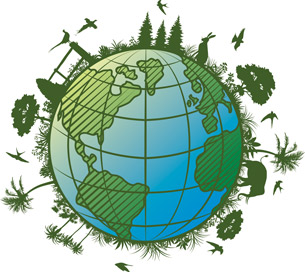
© John Woodcock/iStockphoto
How does the model that you created in the Lesson 2 Lab: Biosphere in a Bottle, explain or demonstrate what is finite and infinite in the world that you live in? Post your ideas in the discussion area.
 Reflect on the Big Picture
Reflect on the Big Picture
Does this lesson reinforce the idea that people are all connected as one? Explain why or why not. Put your answer in your course folder. It will be used for your module project.
 Module 2: Lesson 2 Assignment
Module 2: Lesson 2 Assignment
Remember to submit the Assignment answers to your teacher as part of your Module 2: Lesson 2 Assignment.
1.11. Page 5
Module 2—Biosphere Equilibrium and the Impact of Humans
 Lesson Summary
Lesson Summary
In this lesson you explored this essential question:
-
How does the relationship between gas exchange in photosynthesis and cellular respiration influence the composition of the atmosphere?
Two biological processes—photosynthesis and cellular respiration—are hugely important to the biosphere. These processes have, over a billion years, established the balance of oxygen and carbon dioxide that all life on Earth depends on. What happens when humans try to recreate that balance, for example, when you tried to create a biosphere in a bottle? It is not easy, yet despite knowing how difficult it is to maintain a balance, people continue activities that alter the atmosphere in a variety of ways which scientists propose is causing global warming.
As you move into Lesson 3, you will see the large ecological footprint that people leave behind them as they move into the future. Should people be worried?
Lesson Glossary
anoxic: lacking free oxygen
stromatolites: sedimentary rock in oceans built from fossilized micro-organisms, such as bacteria
1.12. Lesson 3 Intro
Module 2—Biosphere Equilibrium and the Impact of Humans
Lesson 3—The Ecological Footprint of Humans
 Get Focused
Get Focused
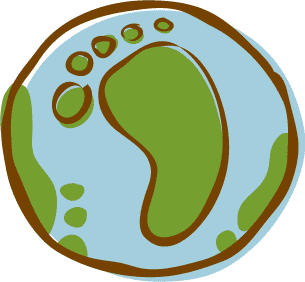
© BaeBae Design/iStockphoto
Footprints follow you wherever you go. Police use footprints as evidence. Footprints show where you have been. Footprints leave marks. You know that you leave a footprint when you walk in sand, for example, but what about your ecological footprint? What kinds of things that you do or use leave a footprint on the biosphere? If you keep the thought “we are all connected as one” in mind, does your ecological footprint “step” on others?
Have you ever taken an ecological footprint quiz? To find the quiz, type the keywords “Mountain Equipment Co-op” or “MEC” in a search engine. From this page, use the search box in the top left-hand corner of the site. Enter the keywords “ecological footprint.”
The quiz will allow you to find out how much productive land and water you use to support your lifestyle. Once you reach the end of the quiz, look for the “Take Action” section. Read about how you can reduce your footprint.
What were your results? Is your lifestyle sustainable? Record your results in your course folder for use later in this lesson.
ecological footprint: an analysis of human consumption of natural resources compared to the ability of Earth to recreate them
An ecological footprint gives an estimate of the area in hectares that is required for a human to live based on his or her lifestyle. Most North-American lifestyles are not currently sustainable, according to the analyses.
Consider the following question as you complete this lesson:
-
How do human activities influence the biosphere?
 Module 2: Lesson 3 Assignment
Module 2: Lesson 3 Assignment
Your teacher-marked Module 2: Lesson 3 Assignment requires you to submit a response to the following:
-
TR 1. Ecological Footprints
-
Reflect and Connect
You can access your Module 2: Lesson 3 Assignment. You can print off the assignment or save the download to your computer. Your answers can be saved on this document to your course folder.
You must decide what to do with the questions that are not marked by the teacher.
Remember that these questions provide you with the practice and feedback that you need to successfully complete this course. You should respond to all the questions and place those answers in your course folder.
1.13. Page 2
Module 2—Biosphere Equilibrium and the Impact of Humans
 Explore
Explore
The use of finite, natural resources and the consequent production of pollution degrade the life-support systems on Earth. Biogeochemical cycles and the process of photosynthesis are life-supporting cycles that you have studied. High consumption and usage of resources, and the resulting pollution, cause these cycles in each ecosystem to be less able to perform vital functions that support all life forms.
sustainable: capable of being continued with minimal long-term effects on the environment
North America is a huge consumer. North American people use more energy, land, and water; eat more food; and produce more waste than any other population on Earth. As outlined in the ecological footprint quiz, people’s activities and lifestyle choices contribute to their impact on the environment. Will your lifestyle choices be sustainable in the future?
Increasingly, we are coming to realise that we are using up more resources than nature can replace and producing far more waste than nature can safely absorb. So, it is sometimes said that the human Ecological Footprint is too large.
The term comes from Our Ecological Footprint: Reducing Human Impact on the Earth written by Mathis Wackernagel and William Rees in 1996.
This book presents calculations which show that the human population requires at least 20% more biologically productive land than we presently have—and that we would need a total of three planet Earths to support us if all the Earth's inhabitants were to live at the standard as people in countries such as the United States of America, Australia or Canada.
For example, the Ecological Footprint of the USA was 9.6 hectares (24 acres) in 1999. This is about the area of 24 football fields. In comparison, the average Canadian lived on a footprint about one quarter smaller (7.2 hectares/18 acres), while the average German required an area less than half the size (4.4 hectares/11 acres).
These 'footprints' are greatly in excess of the ‘fair share’ area of 2.1 hectares (5.2 acres) per person there would be if all the biologically productive land and sea in the world were divided equally by the total number of people in the world.
However, humans are not the only inhabitants of the Earth. So, the figure of 2.1 hectares does not allow any space for the ‘footprint’ needs of other species. If preserving the 10 million other species on Earth requires at least 12% of the biologically productive land on Earth (as recommended by the World Commision on Environment and Development calculation), the available biologically-productive space would shrink from 2.1 to 1.8 hectares per person.
We can calculate if there is enough land for our needs by multiplying the figure of 1.8 hectares per person by the total number of people in the world, and comparing the result with the biologically productive land available. Unfortunately, this shows that we are exceeding the Earth's capacity by 20%.
In other words, we are consuming more than what nature can regenerate and, therefore, are eating up the Earth’s stock of natural capital. Scientists call this situation ‘overshoot’ and say that the amount of land 'borrowed' from the future is really an ‘ecological deficit’.
Many countries greatly exceed the footprint of 1.8 hectares per person. Thus, the footprint overshoot in the USA, for example, is causing an 80% ‘ecological deficit’. This means that they—and the people from many other countries—are ‘borrowing’ resources from the future and from elsewhere in the world without ever being able to pay back the debt.
According to the Living Planet Report for 2000, published by WWF, the international conservation organisaton, ‘If every human alive today consumed natural resources and emitted carbon dioxide at the same rate as the average American, German or Frenchman . . . we would need at least another two Earths’.
Using Ecological Footprint calculations, the report argues that:
The area needed to produce the natural resources consumed and absorb the carbon dioxide emitted by the average North American is almost twice the area required by the average Western European, and some five times greater than required by the average Asian, African and Latin American.
It is the consumers of the rich nations of the temperate northern regions of the world who are primarily responsible for the ongoing loss of natural wealth in the tropics.
© UNESCO
1.14. Page 3
Module 2—Biosphere Equilibrium and the Impact of Humans
 TR 1. Ecological Footprints
TR 1. Ecological Footprints
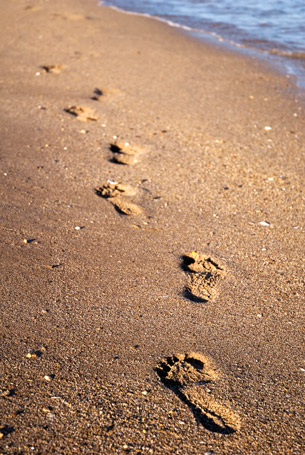
© saluha/iStockphoto
After reading the UNESCO article, you have information about ecological footprints from a global perspective.
![]() To further investigate ecological footprints, please go to your Module 2: Lesson 3 Assignment to complete TR 1.
To further investigate ecological footprints, please go to your Module 2: Lesson 3 Assignment to complete TR 1.
 Reflect and Connect
Reflect and Connect
Reflect on the results of the ecological footprint quiz you took at the start of the lesson. Based on the results of the quiz and using what you have learned in this lesson, respond to the following questions.
![]() Your responses to these questions will be recorded in the Module 2: Lesson 3 Assignment.
Your responses to these questions will be recorded in the Module 2: Lesson 3 Assignment.
-
How could you make your ecological footprint smaller? Make a list of four choices you could make that would lessen your impact on the balance of the biosphere. Explain how each choice in your list would affect the cycles around you. You may want to do a quick web search to help you identify how your choice would have less impact on the balance of the biosphere.
-
Technology is generally developed to meet your needs and to make you better at completing tasks. Discuss how technology affects your ecological footprint positively and negatively. A rubric is provided in the Assignment to show you how you will be marked.
 Reflect on the Big Picture
Reflect on the Big Picture
If your ecological footprint is a rough average of the footprints in your community, predict how this would affect the Arctic community. Record your response in your course folder.
This is the last Big Picture response for this module. You will use this response and those from the other lessons as support for your Module Assessment. When you are ready, visit the Module Summary and Assessment for details about the Module Assessment.
 Module 2: Lesson 3 Assignment
Module 2: Lesson 3 Assignment
Remember to submit the Assignment answers to your teacher as part of your Module 2: Lesson 3 Assignment.
1.15. Page 4
Module 2—Biosphere Equilibrium and the Impact of Humans
 Lesson Summary
Lesson Summary
This lesson explored the following essential question:
-
How do human activities influence the biosphere?
If the idea of an ecological footprint was new to you, after this lesson you will probably agree that you do leave a mark on the environment. Humans, intentionally or unintentionally, leave these marks—or footprints—everywhere. The trick is to somehow reduce the ecological foot size of one person. By doing so, imbalances in the biosphere, which can cause global warming, may be returned to a sustainable balance. And people, such as the Inuit, may not have to worry about losing their way of life.
You have already begun to leave your mark in this world. The question is, what kind of mark do you hope to leave, and how will the mark affect others? By recognizing that the biosphere is a living organism, you are becoming more aware that human actions in one area are not contained but instead ripple out to touch many other areas.
Lesson Glossary
ecological footprint: an analysis of human consumption of natural resources compared to the ability of Earth to recreate them
An ecological footprint gives an estimate of the area in hectares that is required for a human to live based on his or her lifestyle. Most North American lifestyles are not currently sustainable, according to the analyses.
sustainable: capable of being continued with minimal long-term effects on the environment
1.16. Module Summary/Assessment
Module 2—Biosphere Equilibrium and the Impact of Humans
 Module Summary
Module Summary
Now that you have completed Module 2, you should realize you are not just a passive passenger on Planet Earth. Instead, you are an active organism. Your actions, and the actions of those around you, have an effect on biosphere equilibrium. You leave an ecological footprint.
You should now know that equilibrium is not static. Equilibrium is dynamic. In other words, equilibrium is constantly adjusting to changes in energy flow and cycles of matter. Problems arise when these changes in energy flow and cycling of matter become too extreme for the biosphere to maintain its dynamic balance. The changes are often due to human activities.
As a biology student, you should understand the consequences of human actions on the world around you. Then you can make choices that benefit the well-being of your backyard as well as the biosphere. You learned about the observed effects of climate change in the Canadian Arctic as one example of human influence on the biosphere. This is but one of many consequences of human influence on the biosphere.
In order to look at climate change, it was necessary to look at the changes in Earth’s atmosphere over time. As well, you studied the balance of gas exchange (oxygen vs carbon dioxide).
It is up to you to use the knowledge you have gained in Module 2 in order to take care of the biosphere. As you have witnessed, there is definitely a need for change in the way humans view natural resources. This is evident when you start to look at your own ecological footprint. When you are informed you can make better choices for the biosphere. If you believe that “we are all connected as one,” then you will use what you know to try to ensure that dynamic balance exists between energy and matter.
 Module Assessment
Module Assessment
Module Project
You will be required to prepare a PowerPoint or multimedia presentation, essay, speech, or storyboard exploring a specific example of how global warming is affecting the Arctic ecosystem in terms of energy and matter (e.g., melting ice shelf). You need to incorporate the ideas from the three “Reflect on the Big Picture” responses you stored in your course folder where you made predictions about the Arctic, considered the idea of “connected as one,” and looked at your own personal ecological footprint. In this project, there should be evidence of research and thought about the impact of human activities on the state of biosphere equilibrium.
Assessment Rubric
The following rubric will be used to grade your module project.
4 |
3 |
2 |
1 |
|
|
|
|
When this module is complete, continue on to the Unit Conclusion and the Unit Assessment.
1.17. Module Glossary
Module 2—Biosphere Equilibrium and the Impact of Humans
Module Glossary
anoxic: lacking free oxygen
ecological footprint: an analysis of human consumption of natural resources compared to the ability of Earth to recreate them
An ecological footprint gives an estimate of the area in hectares that is required for a human to live based on his or her lifestyle. Most North American lifestyles are not currently sustainable, according to the analyses.
stromatolites: sedimentary rock in oceans built from fossilized micro-organisms, such as bacteria
sustainable: capable of being continued with minimal long-term effects on the environment